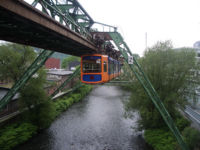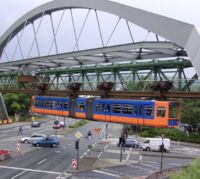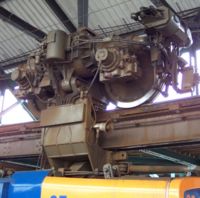Schwebebahn Wuppertal
The Schwebebahn Wuppertal is a suspension railway in Wuppertal, Germany. Its full name is the "Eugen Langen Monorail Suspension Railway" (Einschienige Hängebahn System Eugen Langen). The people of Wuppertal know it, however, as the "Old Lady" or the "Iron Wyvern". Designed by Eugen Langen, who originally planned to build it in Berlin, it was built in 1900, opened in 1901 and is still in use today as a local transport system in the city.
The suspension railway travels along a route 13.3 km long, about 12 m above the surface of the river Wupper and approximately 8 m above the city streets, between the districts of Oberbarmen and Vohwinkel. At one point the railway crosses the A46 motorway. The entire trip, including stops for people to get on and off, takes about 35 minutes.
The Schwebebahn operates within the VRR transport association and accepts tickets issued by the VRR companies.
History
The Wuppertal Schwebebahn had one model: in 1824, Henry Palmer of England first presented the world with a railway system which differed from all previous construction forms. It was basically a small suspension railway on which suspended carriages were drawn by horses.
Friedrich Harkort, a famous German industrialist and politician, loved the idea. He had a system of this type built as a trial in 1826 and ran it on the grounds of what is today the tax office at Elberfeld. He tried to interest the public in his scheme.
On September 9 1826 the town councillors of Elberfeld met to discuss the use of a "Palmer's Railway" from the Ruhr to the Wupper river, mainly for the purpose of supplying the growing city with cheaper coal. Friedrich Harkort inspected the projected route with a surveyor and a member of the town council. The railway was to go from Elberfeld to Hinsbeck or from Elberfeld to Langenberg. The plan never went ahead, however, due to the owners of various pits who had not been included in it and felt disadvantaged at being left out.
The suspension railway which was finally built was planned and tested by the engineer Eugen Langen in Cologne during the 1880s. In 2003 the Rhenish Heritage Office (Rheinische Amt für Denkmalpflege des Landschaftsverbandes Rheinland or LVR) published a press report announcing the discovery of an original section of the test route of the Wuppertal Schwebebahn.
In 1901, after a construction period of about three years overseen by the government's master builder, Wilhelm Feldmann, the railway came into operation in Wuppertal. Around 19,200 tonnes of steel were worked to produce the supporting frame and the train stops. Construction cost 16 million Goldmark. Since its first opening, the railway has remained in continuous use as an overground metro system. Every year about 23 million passengers travel on it (2003).
The Wuppertal Schwebebahn was considered one of the safest means of transport in the world, carrying up to 75,000 passengers a day through the town. Since 1995, the supporting frame has been largely modernised, and a large number of train stops have been reconstructed and brought up to date technically. The "Kluse" stop, at the theatre in Elberfeld had been destroyed during the Second World War; this too was reconstructed during the modernisation. Work was planned to be completed in 2001; however a serious accident took place in 1999 which left 5 people dead and 47 injured. This, along with delivery problems, meant that the completion date was delayed. In recent years (2004) the cost of the reconstruction work has nearly doubled from 225 million to 394 million euro.
Since 2004 many of the train stops have been fitted with CCTV cameras.
In 1950 Tuffi, the circus elephant, jumped from a train into the Wupper during a botched publicity stunt.
Technology
The suspension railway is a monorail suspended from a steel supporting frame with a rail built underneath it. It hangs on wheels which are driven by electric motor.
The supporting frame and tracks are made out of 486 pillars and bridgework sections. At the ends of the route there are turning points and parking spaces for the trains, which turn around so as to carry passengers there and back one after the other. This method of transport, without crossings, is similar to an overground metro system.
One carriage can carry about 200 passengers. The top speed is 60 km/h and the average speed is 26.6 km/h.
In Literature
The Schwebebahn is alluded to in Theodore Herzl's utopian novel Altneuland. (The Old New Land) For Herzl, the Schwebebahn was the ideal form of urban transport, and he imagined a large monorail built in its style in Haifa.[1]
Videos
See also
- Monorail
- H-Bahn
- Schwebebahn Dresden
- MonoMetro
- Memphis Suspension Railway
- List of rapid transit systems
External links
| Wikimedia Commons has media related to: Wuppertaler Schwebebahn |




